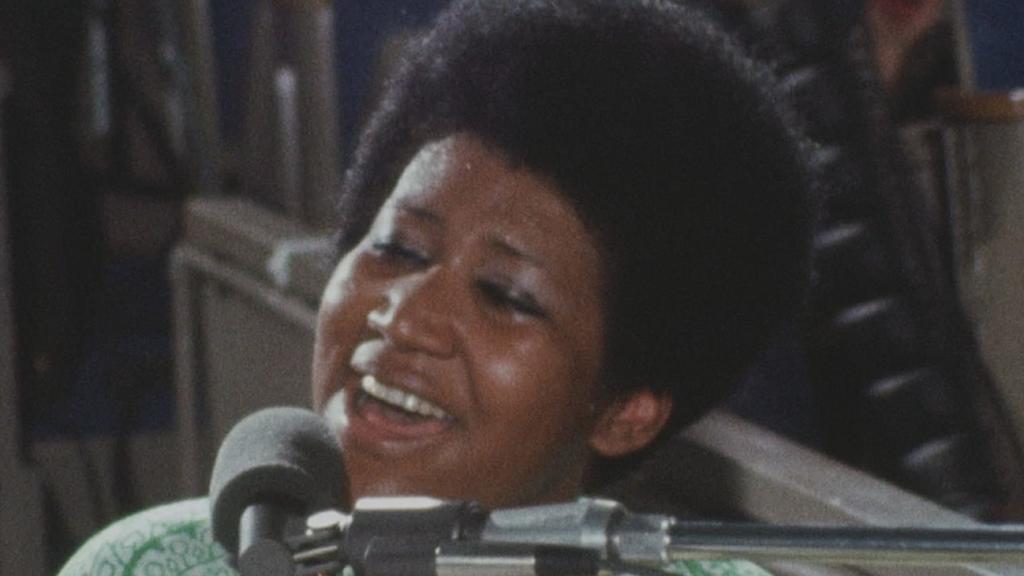
It might have played in a theater near you but make no mistake: Amazing Grace is a church service.
The documentary chronicles the recording of Aretha Franklin’s 1972 double-platinum gospel album over the course of two nights at the New Temple Missionary Baptist Church in Los Angeles. Franklin, accompanied by James Cleveland and the Southern California Community Choir, belts out beloved hymns including “Amazing Grace,” “What a Friend We Have in Jesus,” and “Never Grow Old” for an audience that becomes increasingly animated, moved by the presence of the Queen of Soul and the power of these timeless songs.
The film impressed critics (it has a 99% rating on Rotten Tomatoes), with reviewers using words such as “miraculous” and “transcendent.” Peter Travers of Rolling Stone remarked, “The voice of Aretha Franklin is touched by God.” I am not someone who typically responds to live music; even in the most passionate worship service or at the most raucous concert, I’m reserved. But as the film played, I found myself tapping my leg, swaying in my seat, and even applauding. Looking around the theater, I realized I wasn’t alone.
I’m not saying everyone who loves this movie has had a religious experience, but I’m not discounting it, either. I know what I felt. There is something about this voice singing these songs that stirs the soul. Franklin gives a powerful performance that prompts an ecstatic response from her audience. Somehow, that charisma reaches beyond the scrim of the movie and television screens to stir modern audiences. That might just be good moviemaking, but it feels supernatural.
That would be fitting. Because from its opening moments, Amazing Grace is an ode to the demanding work of worship and how it sparks a communal joy that transcends the boundaries of space, time, and even cinema.
The hard work of worship
One of the film’s recurring images is Franklin’s face coated in sweat. It’s a key visual that not only immerses us in that church on those summer nights, but also communicates that while Franklin is performing beloved religious songs, this is also her profession. She is there to record a worship album with the same commitment and skill that made her an icon.
The perspiration is proof of the effort, and the filmmakers linger on the work that goes into the performance. There is a moment where Franklin stops a song and asks Cleveland to begin again so she can hit the proper note. Most concert films would discard this; director Sydney Pollack uses it to showcase her intense focus. Following Franklin’s lead, everyone on stage is inspired to fully commit because of who they’re singing with — and, presumably, what they’re singing about.
The album was not simply a showcase for Franklin; it was a collaboration. Cleveland, one of the most well-known presences in gospel music, throws himself into his accompaniment and his role as an emcee, priming the audience. The choir, led by director Alexander Hamilton, is always at the ready; this combination of a mass choir and a soul superstar elevates the material from familiar Sunday morning songs to hymns resonating with passion and power. The microphone cables that criss-cross the stage are constant reminders that this performance is the work of professionals at the top of their field; a throwaway moment where Cleveland requests a cup of water for Franklin, who receives it almost instantly, is a testament to how focused the entire team was.
Bringing this project to the screen was an immense collaborative effort, and it’s one we catch glimpses of throughout the film. There are constant shots of cameramen scurrying to capture a better angle of either the stage or the sanctuary; in one fleeting moment, we see Pollack gesture wildly for his cameraperson to record the crowd. They only had two nights to record, and you can almost hear the camera crew huffing to get in location and feel the effort of editor Jeff Buchanan as he cuts from the pulpit to the crowd and back, attempting to showcase it all.
But all that hard work almost went for naught. Pollack was hired to document the recording for Warner Brothers, but a technical snafu caused the film to be thought unwatchable for decades. It wasn’t until producer Alan Elliott (who receives a co-director credit) bought the prints in 2008 and dedicated himself to restoring the project that it seemed possible the film would ever screen for audiences. Even when the film was complete, it was held up by legal complications from Franklin; after her death, Elliott and the film’s producers showed the completed footage to the singer’s family, who gave the go-ahead to finish the film. Beyond filming the project, restoring and bringing it to the screen required the hard work and cooperation of many.
Thinking of the many people required to bring this project to fruition and of Amazing Grace’s spiritual roots made me consider the work that goes into facilitating our own Sunday morning worship. I take for granted that our praise team has spent hours practicing the songs we sing, and often forget that the only reason I can hear them is because of someone sitting at the soundboard. The reason I know the words to the songs is that someone has transcribed the lyrics to PowerPoint (instead of being gracious, I keep an eye out for typos). Many people are only able to participate because of a spouse or nursery volunteer looking after their kids while they sing. It’s easy to overlook the talent and work, especially behind the scenes, that goes into facilitating our worship services.
It feels, in a sense, almost wrong to refer to it as work; it should be our gift to God, right? But, as Amazing Grace shows, worship requires effort and excellence. It always has, stretching back to the earliest days of Israel, when God directed the nation’s most-skilled artisans to use their time and talents to craft the tabernacle and its furniture. Throughout Scripture, we see the work of poets, historians, and songwriters who put pen to parchment to tell God’s story. Effort and excellence are why the works of C.S. Lewis, Flannery O’Connor and Johnny Cash endure today; God uses that hard work to elicit a response in those who encounter read, sing, or listen. While we could ask whether Franklin and her collaborators were only pursuing monetary success, we should remember there is an industry focused on creating worship music and making money from it, and it still moves us. Despite our own craven intentions, God can use these works to stir our souls.
Contagious, communal joy
A listen to Amazing Grace shows just how essential the congregational response is to the album’s impact. As Franklin savors each line, audience members cheer and shout affirmations, an aural element as crucial to the album’s success and power as the accompanying organ or choir. Onscreen, this is even more potent, as people jump to their feet with hands raised, dance in the aisles, and weep with joy. At one point, gospel legend Clara Ward — invited as a guest — rises to her feet and then collapses back in her chair, exhausted by the ecstasy.
Is this authentic worship, or is it the fervor of seeing a superstar in person, in her prime? I can’t speak to that. But there’s a fantastic moment that I found quite telling. Midway through the film, the camera locates a young Mick Jagger standing in the back of the church. As suddenly as he comes into focus, several people leap to their feet, obscuring our view of the Rolling Stone. It’s almost as if they’re talking back to the filmmakers; this isn’t about superstars, it’s about something bigger.
There’s a steady rhythm with which the 1972 audience becomes an active participant. Early on, they are respectful and welcoming. As Franklin’s voice soars, their reaction gains more steam; they become vocal, animated, boisterous. By the end of the second night, the audience is nearly indistinguishable from the choir. The passion that fuels Franklin and the Southern California Community Choir is contagious, spreading into the crowd, and removing the line between performer and audience; in the end, it stops being a performance and becomes a time of communal praise.
In an act that feels less like movie magic and more like spiritual epiphany, that passion and joy flow into theaters nearly 50 years removed from 1972 L.A. To say the film is entertaining is an understatement; when Franklin hits a high note on “Amazing Grace,” it prompts chills. When the crowd grows boisterous during “Old Landmark,” I felt their ecstasy. When Aretha closes with a thunderous rendition of “Never Grow Old,” my thoughts were directed heavenward. I don’t know what was going through the minds of my fellow filmgoers, but I was drawn to worship. The familiar songs gained a power they hadn’t held before, and I was prompted to thank God for this iconic voice, these timeless songs, and the craft of the filmmakers. What occurred in a church in Los Angeles 47 years ago moved me on a Tuesday night in Detroit in 2019.
I once had a pastor who explained that worship is “all that we are responding to all that God is.” I thought about that as I left the theater. The sheer amount of effort on display in Amazing Grace, evident in the sweat on Franklin’s face and in the exertions of Cleveland and the choir, was a picture of talented individuals giving all in service of something they believed in. The result? Two nights of communal joy, the best-selling gospel album of all time, and a theatrical experience that has moved agnostic critics and turned multiplexes into worship centers.
That, to me, is an example of what we should desire in our Sunday morning worship, in our day jobs, and in our hobbies. If we pour all we have into our worship, the result is something bigger and more contagious than we can comprehend. We do our work and worship in a particular time and location; God can move it to places and use it for purposes we can’t even imagine.











